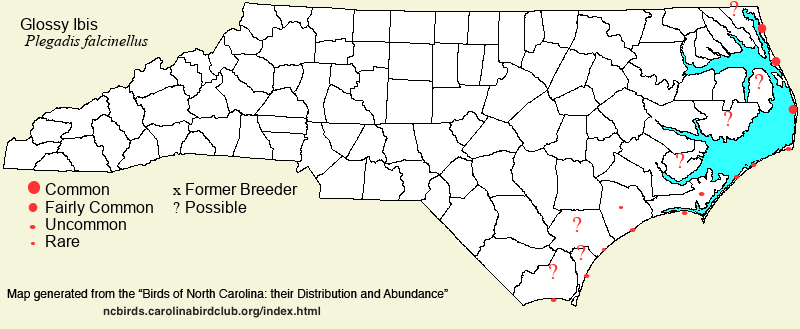 |  |
|
Glossy Ibis - Plegadis falcinellus THRESKIORNITHIDAE Members: | Search Common: Search Scientific: |
|
|
|||||||
| General Comments | The history of the Glossy Ibis is somewhat the reverse of that of the White Ibis. Though it also is a relatively new breeder to the state, first nesting in 1940, it increased and became more widespread through the 1970's but has decreased in recent decades. It is typically the "lowest man on the totem pole" in terms of choice nesting sites in multi-species colonies, and thus can get crowded out of colonies if other species increase or nesting sites decline due to habitat loss. Fortunately, the species decline in North Carolina is partly attributed to a northward shift in the nesting population, as the range has expanded northward to New York and New England in recent decades. Glossies have always been rare in winter along the coast, and it is one of our more strictly coastal breeding waders, as no nesting colony has been been found away from the coast. Glossies feed mainly in shallow fresh or brackish waters, or in short grass or in mud. As with White Ibises, they often feed in fairly tight flocks. Unlike the White, however, Glossies are quite scarce inland, at any season. However, for some unexplained reason, numbers have been truly impressive at Mattamuskeet NWR in the past few years, for most of the year, even though there seems to be no nesting colony within a few miles of that site. Apparently the large numbers in April mostly depart to scattered nesting colonies near the coast or to the north of the state. | ||||||
| Breeding Status | Breeder | ||||||
| NC BRC List | Definitive | ||||||
| State Status | SC | ||||||
| U.S. Status | |||||||
| State Rank | S1S2B | ||||||
| Global Rank | G5 | ||||||
| Coastal Plain | Breeding summer resident along the coast, but sparse (and declining) in winter; post-breeding visitor or migrant inland. Uncommon to locally fairly common along the coast in the warmer months; nests with other waders on small coastal islands; mainly early Mar to mid-Nov; rare in early winter, mostly in the Bodie-Pea island area, but very rare in Jan-Feb. Rare in the Tidewater zone in the warmer months, and very rare in winter (though somewhat regular and surprisingly increasing in recent winters and springs at Mattamuskeet NWR). Farther inland, a very rare migrant and post-breeding visitor; late Mar to early Jun, and early Jul to late Sep. One far-inland winter report: 1, Pitt, 26 Jan 1997. Peak counts: 385, Mattamuskeet NWR, 17 Apr 2016; 300, Mattamuskeet NWR, 13 Apr 2014; 120, Mattamuskeet NWR CBC, 29 Dec 2009; 110 at this refuge, 20 Dec 2013 and 90 there on 29 Dec 2013; 85, same area, 25 Jul 2009. Far inland peak counts: 16, in flight over Vandemark Farms (Nash) on 2 Aug 2020; 13, near Leggett (Edgecombe) on 30 Jul 2024; 10, in Sampson on 23 Jul 2013. | ||||||
| Piedmont | Migrant and post-breeding visitor. Rare in the eastern portion (mainly in the Jordan and Falls lakes area), but very rare elsewhere; mainly late Mar to mid-May and early Jul to mid-Sep; no records between early Nov and late Mar. Peak counts: a remarkable 30, photographed in flight, over Mountain Island Lake (Mecklenburg), 2 Apr 2016; 13, in flight over Lake Crabtree (Wake), 7 Apr 2022; 13, at Lake Crabtree, 26 Apr 2024; 9, Lake Crabtree, 13 Sep 2017. | ||||||
| Mountains | Casual to very rare visitor; with only nine known reports. One seen at Altamont (Avery) on 12 Apr 1998; one photographed in the French Broad River Valley of Henderson on 10 May 2012, and in the same location on 19-21 Sep 2012; one photographed at Jackson Park in Hendersonville (Henderson) on 24 Apr 2014; one in flight over Beaver Lake (Buncombe) on 14 Sep 2020; one over the entrance road to Grandfather Mountain (Avery) on 30 Sep 2020; one at Mills River Park (Henderson), 11 Apr 2022; three in Buncombe, 30 May 2025; and one at a different site in that county, 20 Apr 2025. | ||||||
| Finding Tips |
This species has been somewhat more difficult to find along the coast in the spring to fall seasons in recent years. The species can usually be found in a given day in the Bodie and Pea islands area, except in winter. They can be seen around most of the ponds in the area, but it may take some scoping. It can be missed southward, but it does nest at scattered sites to the Cape Fear area. *** | ||||||
| Attribution | LeGrand[2025-07-27], LeGrand[2025-02-03], LeGrand[2024-11-04] | ||||||
| NC Map Map depicts all counties with a report (transient or resident) for the species. | Click on county for list of all known species. |
| NC Breeding Season Map Map depicts assumed breeding season abundance for the species. |  |